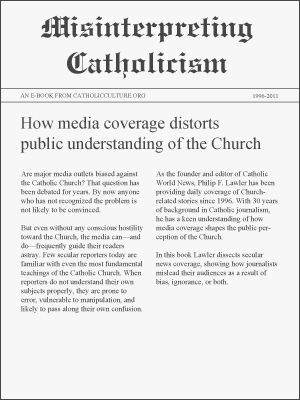Veils in Church: Style, threat, or testimony?
By Dr. Jeff Mirus ( bio - articles - email ) | Aug 27, 2024
A very well-informed friend sent me a link to an article on the increased numbers of young Catholic women wearing veils in Church. I have certainly noticed this among Hispanic women in my own parish, for whom this is still a tradition, and among those characterized by a kind of piety that cherishes—and I do not mean “brandishes”—external signs of devotion. But apparently it is a wider trend, and includes a generation of younger women who were not raised in veils.
Free eBook:

|
| Free eBook: Misinterpreting Catholicism |
On balance, I regard this as a good thing, in much the same way as I like to see men using a pocket as a repository for their rosaries, and to see those rosaries coming out during times of prayer. Of course, a veil is a stronger outward sign and one with Scriptural warrant, and so ought to be highly recommended. But there are spiritual pitfalls everywhere. Speaking purely for myself, I would like to ban the sequin-laden veils which constantly reflect the Church’s ceiling lights, distracting the attention of others. The purpose of the veil is to signify humility before God. It loses its charm the instant it becomes either a distraction or a fashion statement.
Still, in some places it may take not only piety but a bit of courage to wear a veil (even if the “veils” of which we are speaking are not of the sort that cover the face). If I am reading the cultural signals correctly, I would say that in most cases wearing a veil in Church is a feminine statement of reliance on God’s plans and not those of the dominant culture—not those of this world. Indeed, the only people who are likely to be angered by women wearing veils are those who see the veil as a mark not of devotion but of female subjugation to males. But really, a man would have to be either very vain or extraordinarily dirty to make a point of covering his own hair, whereas for a woman the Christian purpose is deliberately to subdue one of her glories, as a sign of modesty before her Lord and God.
One can have the inward disposition of such humility, of course, without the outward sign of the veil. But if the disadvantage of outward appearances is that they can be used to show off, the advantage is that they are a good example to others. Both those who wear veils and those who do not are called to be models of humility, a truth which of course applies to men and women equally, even if the veil is part of the spiritual arsenal of the female, and not of the male.
After all, a male shows a proper deference for God and the sacred precisely by removing his hat in Church. I once walked to a Catholic church for Mass on a very sunny day while on vacation, forgetting that I was wearing a baseball cap to shade my eyes. When I entered the church, one of the ushers reminded me to remove it, and he was quite right. Indeed, it was a superb comeuppance, for I am still annoyed when I see men wearing baseball caps while dining in a restaurant, proving once again the remarkable truth that I am my parents’ child—for I was very carefully taught.
Subservience?
Our culture is littered (and I choose that word advisedly) with those who dislike everything they believe a woman’s veil stands for: Second-class status, subservience to men, a refusal to appreciate and celebrate their own “dignity”. The media, of course, is full of women who regard every kind of exposure, whether of mind or body, as a celebration of their dignity, and we ought to judge reasonably whether it is their dignity that is on display or something else entirely. But just as men seldom celebrate their dignity without making fools of themselves, so too do women who deliberately push themselves forward betray a fundamental insecurity, and even a fundamental misunderstanding of that quiet strength which packs more dignity than any noisy or grasping intervention can ever do.
It is probably mostly for this reason that women who wear veils are seen as threats to those women who have a completely wrong idea of what constitutes their true dignity as daughters of a loving Father. Those who find the veil threatening—and who wish either to emancipate or eliminate those who do not—are extraordinarily insecure. It is hard to blame them, considering the decadent culture in which they have been raised, a culture which presses them at every turn to deny their own “femaleness” as if this is the key to their fulfillment as human persons. So deeply enculturated is this reflexive denial that the wearing of a veil in Church can even be viewed as an attack on everything women are now supposed to hold dear.
That is why the wearing of veils in Church (when it is not a fashion statement) is also a witness against our dominant culture in one of the few relatively safe places in which a woman can actually be herself without being mocked, derided and dismissed. It may be one of those things that comes around and goes around with cultural swings, but it is hard to avoid recognizing today that the intentional wearing of a veil in Church is not only an expression of humility before God but also a kind of declaration of war against a decadent Western culture which has formally, legally and officially betrayed women by denying their very natures: A culture that has given them over to the worst kinds of abuse, utterly refusing even to begin to protect them from increasingly systemic and rampant forms of predation.
It is just possible that today, if adopted in the right spirit, wearing a veil in Church is one way for a woman to state with extraordinary clarity that she is the daughter of a Father she can trust, and that despite the transient horrors of a fallen world, she will never—not even for a single prodigal moment—allow herself to confuse rebellion with freedom, or abuse with love.
All comments are moderated. To lighten our editing burden, only current donors are allowed to Sound Off. If you are a current donor, log in to see the comment form; otherwise please support our work, and Sound Off!
-
Posted by: garedawg -
Aug. 27, 2024 11:38 PM ET USA
Growing up as a Protestant in the South, I still get nostalgic for the days when people would dress to the hilt and women would wear beautiful hats.
-
Posted by: mary_conces3421 -
Aug. 27, 2024 7:19 PM ET USA
Very thoughtful and well-balanced, as usual. Personally, I'm old and afflicted with sensitivity to cold and somewhat fuzzy hearing. Veils are lovely, but serve neither purpose. I use scarves and hoods to keep my ears warm and put them down to hear an un-miked sermon at weekday Mass. In dress, I strive not to be a distraction to others or myself; never to Make a Statement; nor to dwell on what others are wearing. (Difficult for a woman.) Most of the women I know wear veils to foster reverence.







